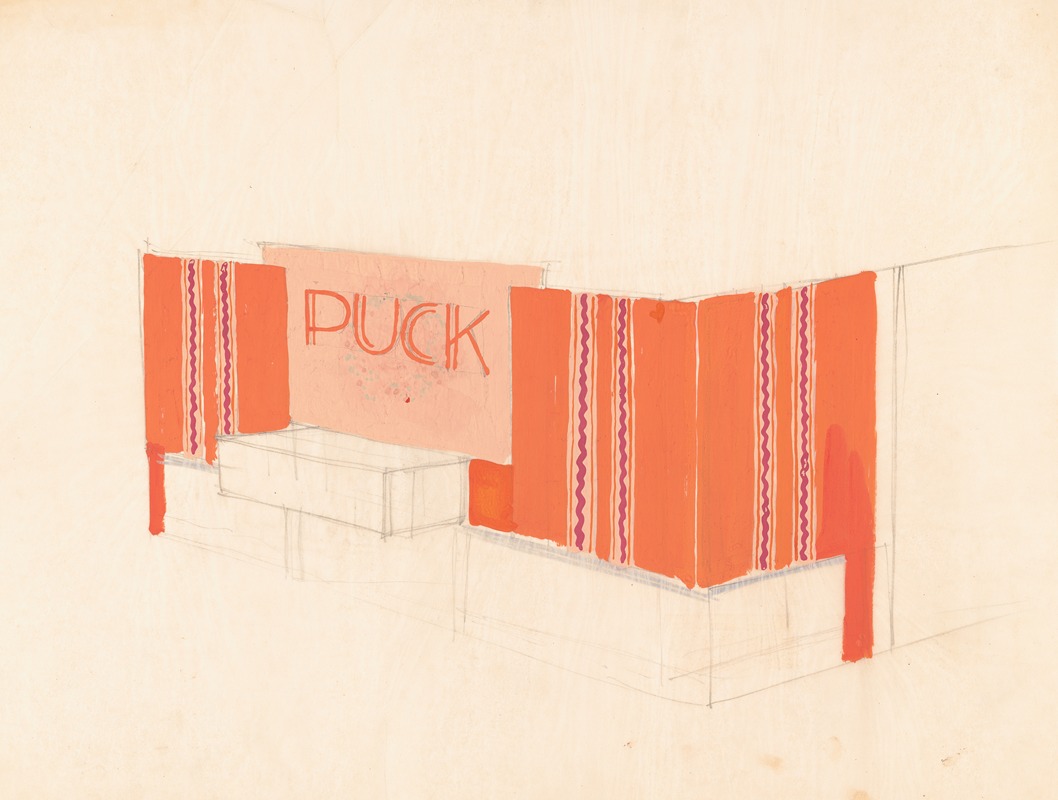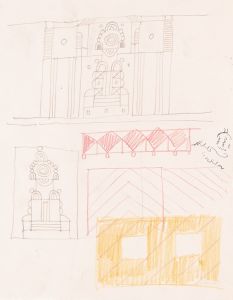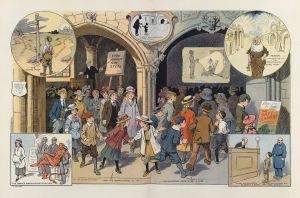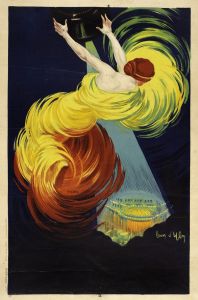
Designs for the Puck Theater , New York, NY.] [Exterior perspective study..
A hand-painted replica of Winold Reiss’s masterpiece Designs for the Puck Theater , New York, NY.] [Exterior perspective study.., meticulously crafted by professional artists to capture the true essence of the original. Each piece is created with museum-quality canvas and rare mineral pigments, carefully painted by experienced artists with delicate brushstrokes and rich, layered colors to perfectly recreate the texture of the original artwork. Unlike machine-printed reproductions, this hand-painted version brings the painting to life, infused with the artist’s emotions and skill in every stroke. Whether for personal collection or home decoration, it instantly elevates the artistic atmosphere of any space.
Winold Reiss was a German-American artist and designer known for his work in portraiture, graphic design, and interior decoration. Born in 1886 in Karlsruhe, Germany, Reiss immigrated to the United States in 1913, where he became a prominent figure in the American art scene. His diverse body of work includes designs for public spaces, murals, and illustrations, reflecting a blend of European modernism and American themes.
One of Reiss's notable projects was his involvement in the design for the Puck Theater in New York City. The Puck Theater, named after the mischievous character from Shakespeare's "A Midsummer Night's Dream," was part of the Puck Building, a historic structure located in Manhattan's Nolita neighborhood. The building itself, completed in 1893, is an example of Romanesque Revival architecture and has been a significant landmark in New York City.
Reiss's contribution to the Puck Theater included an exterior perspective study, showcasing his vision for the theater's design. This work is a testament to his skill in architectural rendering and his ability to integrate artistic aesthetics with functional design. Reiss's design for the Puck Theater would have been influenced by his background in European art and his exposure to American culture, resulting in a unique architectural perspective.
Throughout his career, Reiss was known for his vibrant use of color and his ability to capture the essence of his subjects, whether in portraiture or architectural designs. His work often incorporated elements of Art Deco and modernist styles, which were popular during the early to mid-20th century. Reiss's designs were characterized by their bold lines, geometric patterns, and a keen attention to detail, all of which can be seen in his study for the Puck Theater.
In addition to his architectural and design work, Winold Reiss was also celebrated for his portraits of Native Americans and African Americans, which he approached with a sense of respect and dignity that was uncommon at the time. His portraits were not only artistic achievements but also important cultural documents that highlighted the diversity of American society.
Reiss's legacy in the art and design world is significant, as he bridged the gap between European and American artistic traditions. His work on projects like the Puck Theater demonstrates his versatility as an artist and his ability to adapt his style to different mediums and purposes. Today, Reiss's contributions are recognized for their artistic merit and their role in shaping the visual culture of early 20th-century America.
While specific details about the Puck Theater's design and its execution may not be extensively documented, Reiss's involvement in such projects underscores his influence and the breadth of his work. His designs continue to be studied and appreciated for their innovative approach and their reflection of the dynamic cultural landscape of his time.





![Designs for promotional material for opera singer Emanuel List.] [Drawing for brochure page](/imgs/249246/s/winold-reiss-designs-for-promotional-material-for-opera-singer-emanuel-list-drawing-for-brochure-page-130d6349.jpg)
![Graphic designs for Fortune Magazine.] [Study for cover with telephone lines at different locations on the globe](/imgs/249255/s/winold-reiss-graphic-designs-for-fortune-magazine-study-for-cover-with-telephone-lines-at-different-locations-on-the-globe-d53cdea6.jpg)
![Design drawings for Club Gallant project, New York, NY.] [Study for Club Gallant exterior](/imgs/249273/s/winold-reiss-design-drawings-for-club-gallant-project-new-york-ny-study-for-club-gallant-exterior-822ea339.jpg)
![Design for fine art print, ‘The Mad Dancer’.] [Woodcut print](/imgs/249286/s/winold-reiss-design-for-fine-art-print-the-mad-dancer-woodcut-print-c03b5ea2.jpg)
![Designs for the Puck Theater , New York, NY.] [Exterior perspective study](/imgs/249327/s/winold-reiss-designs-for-the-puck-theater-new-york-ny-exterior-perspective-study-df16fd5a.jpg)
![Designs for the Puck Theater , New York, NY.] [Exterior perspective study](/imgs/249328/s/winold-reiss-designs-for-the-puck-theater-new-york-ny-exterior-perspective-study-9c896b94.jpg)
![Interior design sketches for Alamac Hotel, 71st and Broadway, New York, NY.] [Incomplete interior perspective of a hallway](/imgs/249365/s/winold-reiss-interior-design-sketches-for-alamac-hotel-71st-and-broadway-new-york-ny-incomplete-interior-perspective-of-a-hallway-e54f10f2.jpg)
![Interior perspective drawings of Hotel Siwanoy, Mount Vernon, NY.] [Interior perspective, unidentified room in pink, vermillion, and black](/imgs/249371/s/winold-reiss-interior-perspective-drawings-of-hotel-siwanoy-mount-vernon-ny-interior-perspective-unidentified-room-in-pink-vermillion-and-black-69402656.jpg)
![Design proposals for Puck Theater, New York, NY.] [Interior perspective study](/imgs/249412/s/winold-reiss-design-proposals-for-puck-theater-new-york-ny-interior-perspective-study-27d2bb72.jpg)
![Design proposals for Puck Theater, New York, NY.] [Interior perspective study.](/imgs/249414/s/winold-reiss-design-proposals-for-puck-theater-new-york-ny-interior-perspective-study-ba0eb061.jpg)


